Class 10 - Mathematics
Coordinate Geometry - Exercise 7.4
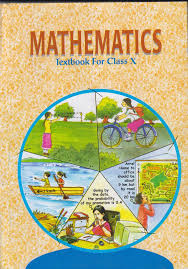
Top Block 1
Exercise 7.4
Question : 1:Determine the ratio in which the line 2x + y – 4 = 0 divides the line segment joining the points A(2, – 2) and B(3, 7).
Answer :
Let the given line divide the line segment joining the points A(2, −2) and B(3, 7) in a ratio k : 1.
Coordinates of the point of division = {(3k + 2)/(k + 1), (7k – 2)/(k + 1)}
This point also lies on 2x + y − 4 = 0
So, 2(3k + 2)/(k + 1) + (7k – 2)/(k + 1) − 4 = 0
⇒ 2(3k + 2) + (7k – 2) – 4(k + 1) = 0
⇒ 6k + 4 + 7k – 2 – 4k – 4 = 0
⇒ 9k – 2 = 0
⇒ 9k = 2
⇒ k = 2/9
Now, k : 1 = 2/9 : 1 = 2 : 9
Therefore, the ratio in which the line 2x + y − 4 = 0 divides the line segment joining the points
A(2, −2) and B(3, 7) is 2 : 9.
Question : 2:Find a relation between x and y if the points (x, y), (1, 2) and (7, 0) are collinear.
Answer :
If the given points are collinear, then the area of triangle formed by these points will be 0.
Area of triangle = (1/2)[x1(y2 – y3) + x2(y3 – y1) + x3(y1 – y2)]
⇒ 0 = (1/2)[x(2 – 0) + 1(0 – y) + 7(y – 2)]
⇒ 0 = (1/2)[2x – y + 7y – 14]
⇒ 0 = (1/2)[2x + 6y – 14]
⇒ 2x + 6y – 14 = 0
⇒ x + 3y – 7 = 0
This is the required relation between x and y.
Question : 3:Find the centre of a circle passing through the points (6, – 6), (3, – 7) and (3, 3).
Answer :
Let O (x, y) be the centre of the circle. And let the points (6, −6), (3, −7), and (3, 3) be
representing the points A, B, and C on the circumference of the circle.
So, OA = √{(x – 6)2 + (y + 6)2}
OB = √{(x – 3)2 + (y + 7)2}
OC = √{(x – 3)2 + (y – 3)2}
However, OA = OB (Radii of the same circle)
⇒ √{(x – 6)2 + (y + 6)2} = √{(x – 3)2 + (y + 7)2}
Squaring on both sides, we get
⇒ (x – 6)2 + (y + 6)2 = (x – 3)2 + (y + 7)2
⇒ x2 + 36 – 12x + y2 + 36 + 12y = x2 + 9 – 6x + y2 + 49 + 14y
⇒ x2 + 36 – 12x + y2 + 36 + 12y – x2 – 9 + 6x – y2 – 49 – 14y = 0
⇒ -6x – 2y + 14 = 0
⇒ 3x + y – 7 = 0
⇒ 3x + y = 7 …………………1
Similarly, OA = OC (Radii of the same circle)
⇒ √{(x – 6)2 + (y + 6)2} = √{(x – 3)2 + (y – 3)2}
Squaring on both sides, we get
⇒ (x – 6)2 + (y + 6)2 = (x – 3)2 + (y – 3)2
⇒ x2 + 36 – 12x + y2 + 36 + 12y = x2 + 9 – 6x + y2 + 9 – 6y
⇒ x2 + 36 – 12x + y2 + 36 + 12y – x2 – 9 + 6x – y2 – 9 + 6y = 0
⇒ -6x + 18y + 54 = 0
⇒ -3x + 9y – 7 = 0
⇒ -3x + 9y = 7 …………………2
Adding equation 1 and 2, we get
10y = -20
⇒ y = -20/10
⇒ y = -2
From equation 1, we get
3x – 2 = 7
⇒ 3x = 7 + 2
⇒ 3x = 9
⇒ x = 9/3
⇒ x = 3
Therefore, the centre of the circle is (3, −2).
Question : 4:The two opposite vertices of a square are (–1, 2) and (3, 2). Find the coordinates of the other two vertices.
Answer :
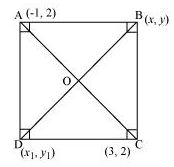
Let (x1, y1), (x2 , y2) be the coordinate of vertex B and D respectively.
We know that the sides of a square are equal to each other.
So, AB = BC
⇒ √{(x + 1)2 + (y – 2)2} = √{(x – 3)2 + (y – 2)2}
Squaring on both sides, we get
⇒ (x + 1)2 + (y – 2)2 = (x – 3)2 + (y – 2)2
⇒ x2 + 1 + 2x + y2 + 4 – 4y = x2 + 9 – 6x + y2 + 4 – 4y
⇒ x2 + 1 + 2x + y2 + 4 – 4y – x2 – 9 + 6x – y2 – 4 + 4y = 0
⇒ 8x – 8 = 0
⇒ 8x = 8
⇒ x = 8/8
⇒ x = 1 …………………2
We know that in a square, all interior angles are of 90°.
In ΔABC,
AB2 + BC2 = AC2
⇒ √{(1 + 1)2 + (y – 2)2} + √{(1 – 3)2 + (y – 2)2} = √{(3 + 1)2 + (2 – 2)2}
⇒ 4 + y2 + 4 − 4y + 4 + y2 − 4y + 4 =16
⇒ 2y2 + 16 − 8 y =16
⇒ 2y2 − 8 y = 0
⇒ y(y − 4) = 0
⇒ y = 0 or 4
We know that in a square, the diagonals are of equal length and bisect each other at 90°.
Let O be the mid-point of AC. Therefore, it will also be the mid-point of BD.
Now, coordinate of O = {(-1 + 3)/2, (2 + 2)/2}
⇒ {(1 + x1)/2, (y + y1)/2} = (1, 2)
⇒ (1 + x1)/2 = 1
⇒ 1 + x1 = 2
⇒ x1 = 1
⇒ (y + y1)/2 = 2
⇒ y + y1 = 4
If y = 0,
y1 = 4
If y = 4,
y1 = 0
Therefore, the required coordinates are (1, 0) and (1, 4).
Question : 5: The Class X students of a secondary school in Krishinagar have been allotted a rectangular plot of land for their gardening activity.
Sapling of Gulmohar are planted on the boundary at a distance of 1m from each other.
There is a triangular grassy lawn in the plot as shown in the Fig. 7.14.
The students are to sow seeds of flowering plants on the remaining area of the plot.
(i) Taking A as origin, find the coordinates of the vertices of the triangle.
(ii) What will be the coordinates of the vertices of Δ PQR if C is the origin?
Also calculate the areas of the triangles in these cases. What do you observe?
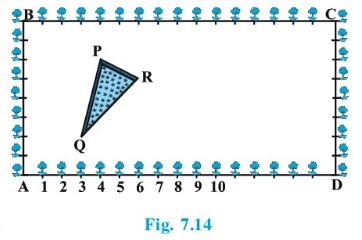
Mddle block 1
Answer :
(i) Taking A as origin, we will take AD as x-axis and AB as y-axis. It can be observed that the
coordinates of point P, Q, and R are (4, 6), (3, 2), and (6, 5) respectively.
Area of triangle PQR = (1/2)[x1(y2 – y3) + x2(y3 – y1) + x3(y1 – y2)]
= (1/2)[4(2 – 5) + 3(5 – 6) + 6(6 – 2)]
= (1/2)[-12 – 2 + 24]
= 9/2 square units
(ii) Taking C as origin, CB as x-axis, and CD as y-axis, the coordinates of vertices P, Q, and R are
(12, 2), (13, 6), and (10, 3) respectively.
Area of triangle PQR = (1/2)[x1(y2 – y3) + x2(y3 – y1) + x3(y1 – y2)]
= (1/2)[12(6 – 3) + 13(3 – 2) + 10(2 – 6)]
= (1/2)[36 + 13 – 40]
= 9/2 square units
It can be observed that the area of the triangle is same in both the cases.
Question : 6:The vertices of a Δ ABC are A(4, 6), B(1, 5) and C(7, 2). A line is drawn to intersect sides AB and AC at D and E respectively,
such that AD/AB = AE/AC = 1/4.
Calculate the area of the Δ ADE and compare it with the area of Δ ABC. (Recall Theorem 6.2 and Theorem 6.6).
Answer :
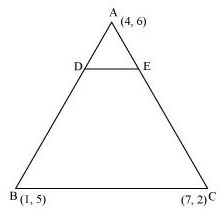
⇒ AD/(AD + DB) = AE/(AE + EC) = 1/4
⇒ AD/DB = AE/EC = 1/3
Therefore, D and E are two points on side AB and AC respectively
such that they divide side AB and AC in a ratio of 1 : 3.
Coordinate of Point D = {(1 * 1 + 3 * 4)/(1 + 3), (1 * 5 + 3 * 6)/(1 + 3)}
= (13/4, 23/4)
Coordinate of Point D = {(1 * 7 + 3 * 4)/(1 + 3), (1 * 2 + 3 * 6)/(1 + 3)}
= (19/4, 20/4)
Area of triangle = (1/2)[x1(y2 – y3) + x2(y3 – y1) + x3(y1 – y2)]
Area of triangle ADE = (1/2)[4(23/4 – 20/4) + (13/4)(20/4 – 6) + (19/4)(6 – 23/4)]
= (1/2)[3 – 13/4 – 19/16]
= (1/2)[(48 – 52 + 19)/16]
= 15/32 square units
Area of triangle PQR = (1/2)[4(5 – 2) + 1(2 – 6) + 7(6 – 5)]
= (1/2)[12 – 4 + 7]
= 15/2 square units
Clearly, the ratio between the areas of ΔADE and ΔABC is 1 : 16.
Alternatively,
We know that if a line segment in a triangle divides its two sides in the same ratio, then the
line segment is parallel to the third side of the triangle. These two triangles so formed (here
ΔADE and ΔABC) will be similar to each other.
Hence, the ratio between the areas of these two triangles will be the square of the ratio
between the sides of these two triangles.
Question : 7:Let A (4, 2), B(6, 5) and C(1, 4) be the vertices of Δ ABC.
(i) The median from A meets BC at D. Find the coordinates of the point D.
(ii) Find the coordinates of the point P on AD such that AP : PD = 2 : 1
(iii) Find the coordinates of points Q and R on medians BE and CF respectively such that BQ : QE = 2 : 1 and CR : RF = 2 : 1.
(iv) What do yo observe?
[Note : The point which is common to all the three medians is called the centroid and this point divides each median in the ratio 2 : 1.]
(v) If A(x1, y1), B(x2, y2) and C(x3, y3) are the vertices of Δ ABC, find the coordinates of the centroid of the triangle.
Answer :
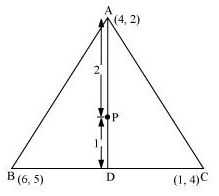
Therefore, D is the mid-point of side BC.
Coordinate of D = {(6 + 1)/2, (5 + 4)/2} = (7/2, 9/2)
(ii) Point P divides the side AD in a ratio 2 : 1.
Coordinate of P = {(2 * 7/2 + 1 * 4)/(2 + 1), (2 * 9/2 + 1 * 2)/ (2 + 1)} = (11/3, 11/3)
(iii) Median BE of the triangle will divide the side AC in two equal parts.
Therefore, E is the mid-point of side AC.
Coordinate of E = {(4 + 1)/2, (2 + 4)/2} = (5/2, 3)
Point Q divides the side BE in a ratio 2 : 1.
Coordinate of Q = {(2 * 5/2 + 1 * 1)/(2 + 1), (2 * 3 + 1 * 5)/ (2 + 1)} = (11/3, 11/3)
Median CF of the triangle will divide the side AB in two equal parts. Therefore, F is the mid-
point of side AB.
Coordinate of F = {(4 + 6)/2, (2 + 5)/2} = (5, 7/2)
Point R divides the side CF in a ratio 2 : 1.
Coordinate of R = {(2 * 5 + 1 * 1)/(2 + 1), (2 * 7/2 + 1 * 5)/ (2 + 1)} = (11/3, 11/3)
(iv) It can be observed that the coordinates of point P, Q, R are the same. Therefore, all these
are representing the same point on the plane i.e., the centroid of the triangle.
(v) Consider a triangle, ΔABC, having its vertices as A(x1, y1), B(x2, y2) and C(x3, y3).
Median AD of the triangle will divide the side BC in two equal parts. Therefore, D is the mid-
point of side BC.
Coordinate of D = {(x2 + x3)/2, (y2 + y3)/2}
Let the centroid of this triangle be O.
Point O divides the side AD in a ratio 2 : 1.
Coordinate of O = {(2 * (x2 + x3)/2 + 1 * x1)/(2 + 1), (2 * (y2 + y3)/2 + 1 * y1)/ (2 + 1)}
= {(x1 + x2 + x3)/3, (y1 + y2 + y3)/3}
Question : 8:ABCD is a rectangle formed by the points A(–1, –1), B(– 1, 4), C(5, 4) and D(5, – 1). P, Q, R and S are the mid-points of AB, BC, CD and DA respectively.
Is the quadrilateral PQRS a square? a rectangle? or a rhombus? Justify your answer.
Answer :
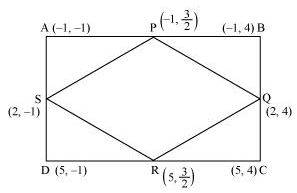
Coordinate of P = {(-1 – 1)/2, (-1 + 4)/2} = (-1, 3/2)
Similarly, the coordinate of Q, R and S are (2, 4), (5, 3/2) and (2, -1) respectively.
Length of PQ = √{(-1 – 2)2 + (3/2 – 4)2} = √(9 + 25/4) = √(61/4)
Length of QR = √{(2 – 5)2 + (4 – 3/2)2} = √(9 + 25/4) = √(61/4)
Length of RS = √{(5 – 2)2 + (3/2 + 1)2} = √(9 + 25/4) = √(61/4)
Length of SP = √{(2 + 1)2 + (-1 – 3/2)2} = √(9 + 25/4) = √(61/4)
Length of PR = √{(-1 – 5)2 + (3/2 – 3/2)2} = √(36 + 0) = 6
Length of SQ = √{(2 – 2)2 + (4 + 1)2} = √(0 + 25) = 5
It can be observed that all sides of the given quadrilateral are of the same measure but
diagonals are not same. However, the diagonals are of different lengths.
Therefore, PQRS is a rhombus.

